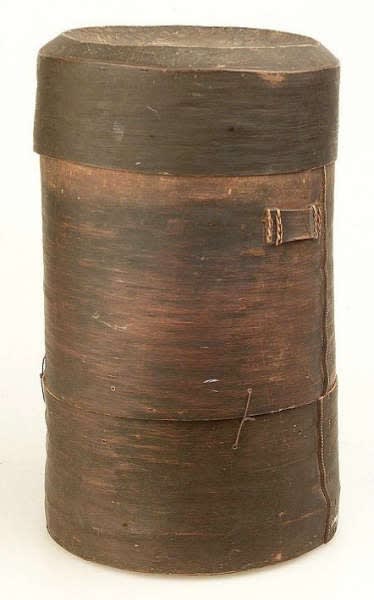
The above bark box was collected by the Dutch explorer Juan Maria Schuver in South Sudan between 1881 and 1883. Unfortunately Schuver didn’t make any notes about this and the three other similar boxes (#2668-25, #2668-26 & #2668-27 – the last one being oval) he collected. We do know for certain that he himself never visited the Mangbetu and Zande region. Possibly he acquired these containers from Zande mercenaries in Sudan or on the market in Khartoum. The early collection date of this example makes it one of the oldest known Zande bark boxes. In the past, these were often described erroneously as honey containers or receptacles for ancestral relics. In fact, they were most often used for holding trinkets, clothing, charms and other personal treasures. Herbert Lang wrote in his field notes about a similar container: ‘A sort of box (nembandi) made of bark and two pieces of wood for a bottom and a cover. They are used to carry the smaller effects of men during voyages and also to store them away in their huts. Most of the objects stored are ornaments, charms, or clothing’. (note 591)
What is interesting about the bark box illustrated above, is the fact that it lacks figurative elements. Most examples in the literature include lids with carved heads on top. There is thus reason to believe that these boxes, like many other forms of Mangbetu and Zande household art, were undergoing changes during the turn of the century. As Schildkrout & Keim demonstrated in African reflections. Art in Northeastern Zaire (University of Washington Press, 1990), the European presence in the region greatly expanded the market for certain types of art. Many chiefs used art to win favor with colonial officials and this new patronage did have consequences for the local material culture. One was that it encouraged the development and spread of certain types of art already present in the region. Artists more and more produced the kinds of works that European and American visitors admired, preferably in the much-loved “Mangbetu style”: an elongated wrapped head and halo-like coiffure which depicted a distinctive turn-of-the-century fashion of upper-class Mangbetu women.
All these objects depicting a Mangbetu-style head were – and unfortunately often still are – called “Mangbetu” no matter who produced it. In many instances works regarded by collectors and museums as most typically Mangbetu were in fact made by Barambo, Bangba, or Zande artists. The art known as Mangbetu was not the exclusive work of Mangbetu artists, but is rather an expression of the political and cultural preeminence of that group at the time it was created.
This Western influence thus transformed certain kinds of traditional objects: for the first time they became vehicles for anthropomorphic sculpture. Pottery is the prime example – sculpted heads were added to the rich inventory of existing shapes – but bark boxes too underwent a redesign. The above example shows the archetype for this type of object. Below another box with a wooden lid and (stool-like) base added. Next a classic example with the typical Mangbetu-style head. Lastly, a container representing a full figure – where the actual box still only makes up a small segment at the center. In a very short period of time – ca. 30 years – this object type thus was subject of a major adjustment due to external influences. The case of the Uele region is well documented thanks to the findings of the American Museum of Natural History’s Congo Expedition (1909-1915), and makes one wonder what happened in many other parts of the D.R. Congo.


